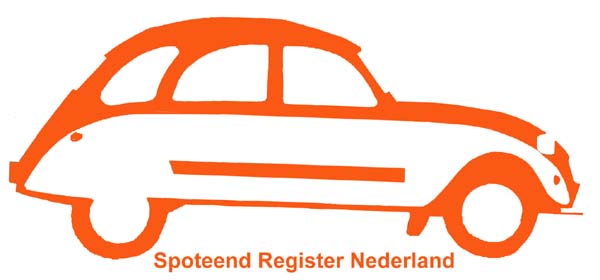
THIS IS AN ARCHIVE COPY OF MY 2CV SPOT WEBSITE FROM 2010 THAT IS SUPPLIED FOR REFERENCE PURPOSES - the actual register is defunct. Last guardian was Henri SchŲnbeck. All content (c) Gromsound 2000-2016

is an attempt that started in 1993 to locate and preserve the remaining CitroŽn 2CV SPOT cars that were delivered in late 1976.
It is not an official car club, but a non-commerial administrative action, and therefore has no formal connections to the many existing CitroŽn clubs or the importer. The register merely informs the present owners of a SPOT that they possess a very rare example of a distinctive limited edition version of the immortal 2CV, and therefore hopes to encourage restoration to the original condition of remaining vehicles.
CONTENT:
What is a 2CV SPOT?
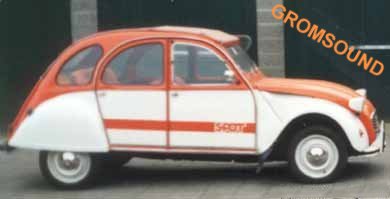
In 1975, CitroŽn realised that the sales of the 2CV were decreasing. They asked a French artist who already designed commercial printed matter, Serge Gevin, to create a special limited edition in order to attract especially the young customers. He came up with two versions he called 'Transat' and 'Trefle'. The first was in essence the SPOT as we know it today, the latter was inspired by the legendary 5CV 'Trefle' and was painted in a yellow-black color scheme.
CitroŽn chose the Transat but named it SPOT (which is sometimes explained by 'SPecial Orange Tťnerť'). The prototype that mr Gevin built was based on a pre-1975 2CV, thus bearing round headlights and a three-bar aluminum grille. He proposed an orange-white striped roof and fitted white plastic wheelrim rings on orange wheels. Both ideas were discarded for the production version (probably for economic reasons).
The final version (post-1975, so equipped with square headlights, grey/chrome plastic grille and black interior door caps) distinguished itself from the stock 2CV by the bright orange (AC329-orange tťnerť) top half of the body, contrasting with the white (AC088 blanc meile) bottom half, including the metal headlight housings, bumpers, wheels with stainless steel hubcaps (as on the Dyane). The interior door panels were vertically orange-white striped, while the upholstery was made of bright orange cloth with orange vinyl backs. Above the front seat, a striped nylon sunscreen (the 'paresoleil') was fitted using springs and clamps. The whole car had a very youthful 'holiday-feeling' air about it. The Spot was based on a 2CV4, exept for the versions for the UK and for Switzerland, which were 2CV6'es (lucky guys!).
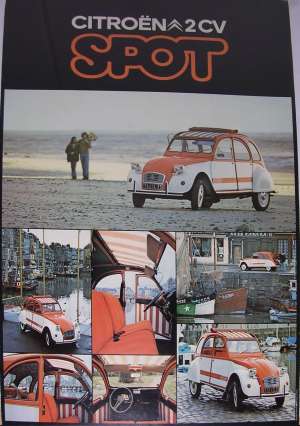 The only
advertising medium: the SPOT dealer poster.
The only
advertising medium: the SPOT dealer poster.
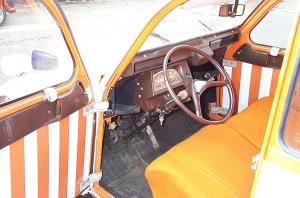 Original French Spot interior: brown
dash and steering wheel.
Original French Spot interior: brown
dash and steering wheel.
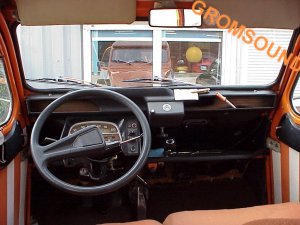 Original Dutch Spot interior: all black
(steering wheel should be hard plastic two spoke type like in
later 2CV special, sorry i have to drive it every day...)
Original Dutch Spot interior: all black
(steering wheel should be hard plastic two spoke type like in
later 2CV special, sorry i have to drive it every day...)
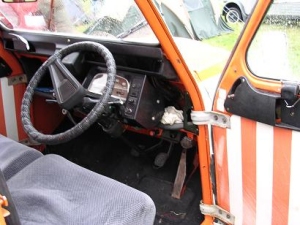 and in RHD it looks like this.
and in RHD it looks like this.
What is left of them today? Of the 1800 cars that were made, 400 (or 450-500 according to some sources) were sold in the Netherlands in october 1976. Today, after years of Spothunting, only 5 of these are known to have survived (more or less) of which 3 are actually roadworthy. The other one is waiting to be restored, although recently a few were imported from France. Three of these were professionally restored and sold to lucky new owners. At least three are known in the UK. Several Spot's were seen in France, most of them in rather tatty condition but still in normal use. Two of these are now beautifully restored! One Belgian Spot was displayed last year. At least two lucky Italians got one. One German bought an Italian Spot recently. Two are now known in Norway which originally imported 30 numbered cars.
The 2CV Spot is somewhat forgotten throughout the years. While older 2CV's like the ribbed-bonnet-types are often restored from scrap, the later examples are generally neglected. This despite the fact that a 2CV Spot is extremely rare, and typical for the colorful mid-seventies. After all, it was the first special edition CitroŽn (even the first special edition French car), which was followed by many more like the 2CV Transat (Beachcomber or France 3), Charleston, Dolly, Cocorico, 007, Perrier. Dyane Caban and several Carte Noire and Leader versions of other contemporary CitroŽns were made. In France, a beginning revaluation is noticeable: some years ago, the leading classic car magazine 'Retroviseur' rated the value of a Spot at about the same level as an AMI6 saloon (ca. 10000 FF).
Today, only the name lives on in jazzed-up versions of the AX and Saxo which are called Spot. No orange-white color schemes nor the typical 'SPOT' logo are used on these cars. Of course, CitroŽn is free to use the name as they wish to. But it seems that the times of a drastic different special edition with original distinguishing features are gone for ever...
Recently it seems that the Spot is back in the picture. A French magazine (Planete 2CV) featured a great article about one. On the annual Citromobile show in Holland, a recent imported Spot on sale was a true crowdpuller. At last, after 10 years of plugging!
Contact Address:
E-mail: (nope sorry it's over)
* 'Eend' is the common Dutch alias for 2CV and means 'Duck' (2CV's fifties nickname was 'ugly duckling' as in the fairytale of Andersen). This may explain the variety of duck-based cartoons and stickers on Dutch and German 2CV's to the bewildered foreigner!
Reactions:
If you happen to know a Spot, or even own one, please tell us! Include the chassisnumber, license plate number, general condition and if possible former history in your reply if you can. Got any additional information on the subject? Used to own one in the past? Suprise us!
Thanks for your interest, and keep on Spotting!
Links:
(just look for yourself type ''spoteend'' or ''2cv Spot'')
© AvW, Spoteend Register NL, 2000-2016. Pictures and text are copyrighted.